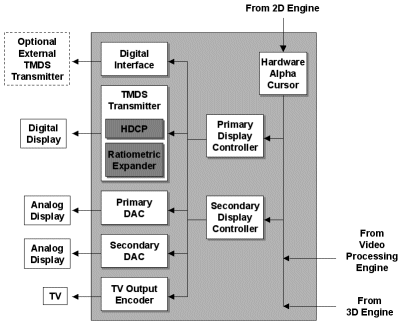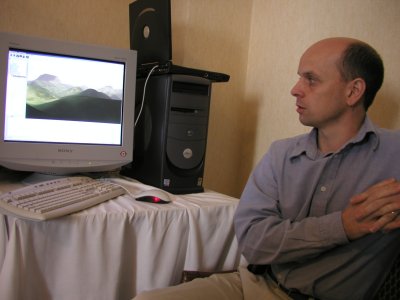ATi Takes Over 3D Technology Leadership With Radeon 9700
Display Output
Matrox introduced it already with Parhelia and it will be a part of Microsoft's DirectX 9; by "it" we mean the new 10/10/10 bit color precision output format that should provide us with a more vibrant image experience. Usual 32-bit color is only using 24-bit for the actual color information, while the remaining 8-bit are not used for the output to a CRT or flat panel. Radeon 9700 is able to use 10-bit precision for each color channel, supplying 1024 different levels of red, green and blue rather than the mere 256 different levels known so far. I am sure that analog output devices have a good chance of benefiting from this new format, while I wouldn't know how digital flat panels are supposed to handle the additional two bits per color channel.
Radeon 9700 comes with the already well known HYDRAVISION software for two simultaneous displays. It has two integrated 10-bit per channel 400 MHz RAMDACs for CRTs, and one integrated 165 MHz TDMS transmitter for digital flat panels. The integrated TV-out supports NTSC/PAL/SECAM formats with a resolution of up to 1024x768.
RenderMonkey
Last but not least, I will only briefly mention our first glimpse at ATi's 3D development tool suite, 'Rendermonkey.' This software can seamlessly be used as a plugin with any of the current 3D-development suites, generating vertex and pixel shader code. Rendermonkey is very comfortable to use for developers as well as artists, and should make the development of titles that use vertex and pixel shaders a lot easier than it has been thus far. Additionally, ATi includes a compiler for Renderman and told us that another compiler for Maya is in the works. Rendermonkey will be available from ATi's website once it has officially been beta-released at SIGGRAPH next week, and it will be free of charge. What we heard is that it is currently regarded as much more useful than NVIDIA's pseudo-standard Cg.
Callan McInally, one of the fathers of Rendermonkey, presents his baby.
Get Tom's Hardware's best news and in-depth reviews, straight to your inbox.
Current page: Display Output
Prev Page Smoothvision 2.0 - Anisotropic Filtering Next Page Performance Evaluation
